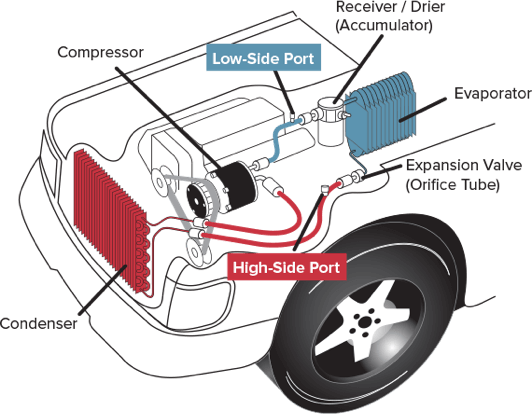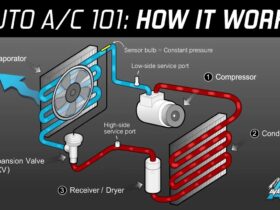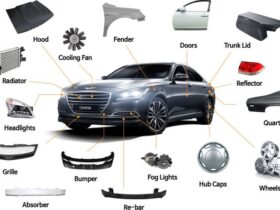Introduction To Automotive AC System Diagram
An automotive AC system is essential for comfort within a vehicle. This system provides passengers with cool air during hot conditions and also aids in demisting windows during colder months. Understanding how this complex system works helps to appreciate the level of comfort it offers in modern vehicles.
The Role Of AC in Vehicle Comfort
An automotive AC system is more than a luxury; it’s a critical component that enhances the overall driving experience.- Temperature Regulation: It maintains a cool and comfortable environment.
- Humidity Reduction: It helps minimize the moisture inside the vehicle.
- Air Quality: It filters out pollutants and circulates clean air.
Evolution Of Automotive Climate Control
The journey from early hand-operated fans to today’s intricate systems showcases significant progress in automotive comfort technology. Early Innovations: First seen in the 1930s, automobiles began implementing basic cooling mechanisms. Technological Advancements: By the 1950s, factory-installed systems elevated user convenience. Modern Systems: Today, vehicles feature automatic climate control tailored to provide optimal comfort.
Basic Components Of An Automotive AC System Diagram
The automotive air conditioning (AC) system keeps your ride cool and comfortable during those hot summer days. Understanding the basic components that make up your car’s AC system can help in maintaining it effectively. Let’s break down these key parts and explore their roles within the system.
Compressor: The Heart Of The System
Think of the compressor as the heart of your vehicle’s AC system. It’s responsible for pumping refrigerant throughout the system. Here’s what the compressor does:- Pressurizes the refrigerant to heat it up.
- Sends the heated refrigerant to the condenser.
- Powered by a drive belt connected to the engine.
Condenser: Releasing The Heat
The condenser acts like a radiator for the AC system. It takes the hot refrigerant from the compressor and cools it down. Let’s take a quick look at how it works:- Located at the front of the car, near the radiator.
- Releases heat to the outside air.
- Returns the cooled refrigerant back to the AC system.
Deep Dive Into Automotive Ac Mechanics
Embarking on a ‘Deep Dive into AC Mechanics’ reveals the inner workings of your car’s air conditioning system. The AC system might seem complex, but at its core, it follows a straightforward process. Understanding the mechanics can help diagnose issues and ensure a cool ride, even on the hottest days.
The compressor increases refrigerant pressure, heating it up. The condenser then cools the refrigerant, changing it from a gas to a liquid. The expansion valve lowers pressure, and the evaporator absorbs heat from the interior, finishing the cycle.
The Refrigeration Cycle Simplified
At the heart of the AC system is the refrigeration cycle. It’s a continuous loop that transforms refrigerant from gas to liquid and back again. Let’s simplify this complex process:- Compression: The compressor squeezes the refrigerant, raising its pressure and temperature.
- Condensation: Hot, pressurized gas flows to the condenser. Here it cools and becomes a liquid.
- Expansion: The liquid refrigerant travels through the expansion valve. It cools down rapidly here.
- Evaporation: Now cooler, the liquid enters the evaporator, absorbs heat from the car’s interior, and reverts to a gas.
Pressure And Temperature Dynamics
Understanding the relationship between pressure and temperature is crucial. Each part of the AC system experiences these dynamics differently:| Component | Pressure | Temperature |
|---|---|---|
| Compressor | High | High |
| Condenser | Lowering | Lowering |
| Expansion Valve | Low | Low |
| Evaporator | Low | Increases |
The Ac System Diagram Unveiled
Every car’s comfort relies on a well-working AC system. A complex journey of cooling starts with a push of a button. The AC system diagram is the map that shows this journey’s path. The diagram helps us see how different parts connect to chill your ride. Let us explore the AC system’s secrets.
Solid lines on the diagram show high-pressure zones. Dotted lines hint at low-pressure areas. Knowing this helps you tell which part of the system is under stress.
Understanding The Layout
To maintain your car’s cool, you must understand its AC layout. This map guides you through parts that keep the air frosty. Here’s a simple breakdown:- Compressor: This part squeezes the refrigerant and sends it on its way.
- Condenser: It turns hot gas into a cooler liquid.
- Receiver-drier: It catches and holds water to keep the system dry.
- Thermal expansion valve: It lets the refrigerant flow at the right amount.
- Evaporator: The liquid becomes cold air here, like magic!
Reading Symbols And Lines
Reading the diagram is like learning a secret language. Symbols and lines tell us important things. Let’s learn their meanings:| Symbol | Meaning |
|---|---|
| Arrow | This shows the direction the cool air is moving. |
| Circle with dots | The compressor is here. |
| Wavy lines | Watch out, the condenser is working here. |
| Drop-like shape | The receiver-drier lives here. |
| Pan-like shape | This is where the evaporator chills the air. |
Exploring The Evaporator’s Role
An automotive AC system diagram reveals various parts working together. One key component is the evaporator. Its job is critical for cool, comfortable air. Let’s dive into what makes the evaporator so important.
Cooling The Air Inside
The evaporator is like a cold sponge in your car’s AC system. It absorbs heat from the air inside the passenger cabin. This happens when the air passes over the evaporator coils. The refrigerant inside these coils carries away the heat. Now, the air can feel cool. This makes your drive on hot days pleasant.Moisture Removal Process
Remove moisture for a fog-free windshield. The evaporator doesn’t just cool. It also dries the air. When warm air meets cold evaporator coils, moisture forms droplets. These droplets are water from the humid cabin air. They collect on the coils and drain outside the car. This keeps your car’s windows clear from fog.- Breathable, dry air
- No fog obstructing the view
- A more comfortable space

Advanced Features In Modern Ac Systems
Advanced Features in Modern AC Systems have transformed the way we experience comfort in our vehicles. From a simple knob turn to intricate electronic controls, automotive air conditioning has seen a revolutionary change. Let’s delve into some of the most innovative features that define modern in-car climate control.
Automatic Temperature Control
With Automatic Temperature Control (ATC), experiencing ideal comfort is effortless. This system maintains a pre-set temperature within the vehicle, adjusting the cooling power as needed. Sensors placed throughout the cabin monitor the temperature, ensuring that the ATC system responds quickly to maintain your desired setting.- Consistent Comfort: The ATC keeps the interior cool, no matter the weather.
- Hands-free Regulation: No need to fiddle with dials; the system does it for you.
- Efficiency: ATC adjusts to use the minimum energy required for comfort.
Dual-zone Climate Management
Dual-Zone Climate Management enhances the driving experience by providing personalized comfort zones. This feature allows the driver and the front passenger to set and enjoy different temperatures simultaneously. It’s particularly useful for long drives where occupants might have different comfort preferences.| Driver Side Temp | Passenger Side Temp |
|---|---|
| 72°F | 68°F |
- Personalized Settings: Create a unique temperature zone on each side.
- Harmony in the Cabin: Eliminate disputes over the AC settings.
- Independent Controls: Easy adjustment without affecting the other zone.
Refrigerants: The Lifeblood Of Ac Systems
A car’s air conditioning (AC) system relies on refrigerants to cool the air. These substances absorb heat and contribute to the comfort passengers feel. Let’s dive into the types of refrigerants used in automotive AC systems, and consider their environmental impact and regulations.
Types Of Refrigerants Used
In automotive AC systems, two main types of refrigerants are common:R-12, also known as Freon, was used in older models.R-134areplaced R-12 and is used in many modern vehicles.
R-1234yf has been introduced. It’s more eco-friendly. This shift reflects ongoing changes in technology and environmental awareness.
Environmental Impact And Regulations
Refrigerants do more than cool the air. They impact the environment when released. The ozone layer can be harmed. Also, they contribute to global warming. Regulations govern the use and disposal of refrigerants. For instance, the Montreal Protocol deals with ozone-depleting substances. The Kigali Amendment works on reducing hydrofluorocarbons (HFCs). In response, car manufacturers and repair shops follow strict guidelines. These prevent refrigerant release into the atmosphere. They ensure proper handling and recycling. Substitutes likeR-1234yf have lower environmental risks. Hence, more systems use it today in alignment with regulations.

Maintaining Your Vehicle’s Ac System
Keeping your car cool during hot days needs a working AC system. Like other parts, it needs care to avoid breakdowns. With the right attention, your car’s AC will be ready for any heatwave. Let’s explore how.
Spot an issue? Get a professional check. DIY fixes might lead to bigger problems.
Routine Inspections And Servicing
To avoid AC trouble, have regular checks. Summer begins? Get your AC inspected.- Check the coolant level: Low coolant means less cooling.
- Inspect the compressor: A bad compressor won’t cool the car.
- Examine belts and hoses: Cracks can lead to leaks.
- Clean the air filter: Dirty filters block air flow.
Troubleshooting Common Issues
Even with care, problems can pop up. Know the signs to fix issues fast.| No. | Issue | What to Check |
|---|---|---|
| 1 | Weak airflow | Blocked air filter or faulty fan. |
| 2 | Not cooling | Low coolant, leaks, or bad compressor. |
| 3 | Strange noises | Loose parts or debris in the system. |
| 4 | Foul smell | Mold in vents or filter needs change. |
The Electronic Side Of Automotive Ac
The modern car relies on electronics to keep its systems running smoothly, and the automotive air conditioning (AC) system is no exception. Let’s dive into the electronic side of automotive AC, which ensures that your driving experience remains comfortable, no matter the outdoor temperature. Advances in sensors and control technology, paired with sophisticated diagnostics, are the unsung heroes of your car’s cool breeze.
Sensors And Controllers
Central to any automotive AC system are the sensors and controllers. These components work together to monitor and regulate temperature, ensuring a balanced climate inside your vehicle. Here’s how they contribute:- Temperature sensors gauge cabin and external air temperatures.
- Pressure sensors keep track of the refrigerant pressure to prevent damage to the system.
- The AC control unit interprets sensor data to adjust cooling output.
- Actuators manage the opening and closing of valves and dampers based on the control unit’s commands.
Customizing Your Ac System
Owners who love their cars often aim to make them better. Customizing Your AC System is a perfect example. The AC system cools the vehicle interior. It offers comfort on hot days. Car lovers can upgrade the system for better performance.
Aftermarket Upgrades
Better AC systems are available beyond factory options. These Aftermarket Upgrades bring new life to your car’s comfort. Key upgrades include:- Better Compressors – More efficient, cools faster.
- Enhanced Condensers – Improved heat dissipation.
- High-flow Air Filters – Cleaner air, less allergens.
Enhanced Performance Tuning
For those who want more, Enhanced Performance Tuning is it. This means tweaking the AC system to perfection. Car enthusiasts seek this for:- Optimal Cooling – Precision in temperature control.
- Energy Efficiency – Using less power to cool.
- Longevity – Making the AC system last longer.
Environmental Concerns And Cooling
Vehicle air conditioning systems play a key role in passenger comfort. But they can harm the environment. Understanding the impact is vital. We must act to reduce harm. The refrigerants used can leak. This can cause global warming. It’s time to be mindful of our choices.
Experts think R-1234yf will become standard. This is because its GWP is much lower than current refrigerants. Car makers are responding. They use these new coolants in their latest models.
Sustainable Practices In Ac Management
Sustainable AC practices are crucial for our environment. Professionals use special tools to prevent leaks during AC service. They recover and recycle refrigerants. Companies are now designing systems that need less refrigerant. This helps protect our planet.- Leak detection during regular maintenance.
- Recycling programs for refrigerants.
- New AC systems built for minimal environmental impact.
Future Of Eco-friendly Refrigerants
The future shines bright for eco-friendly refrigerants. The push is to use substances that do not harm the ozone layer. There is also a focus on reducing global warming potential (GWP). Lower GWP refrigerants help cool our cars without heating up the planet.| Old Refrigerant | GWP | New Refrigerant | GWP |
|---|---|---|---|
| R-22 | 1810 | R-410A | 2088 |
| R-134a | 1430 | R-1234yf | <1 |
Conclusion: Comfort Meets Technology
The intersection of comfort and technology defines today’s automotive AC systems. These marvels offer a cool escape on sweltering days, thanks to a complex network showcased in any automotive AC system diagram. The blend of science and luxury in vehicles brings ease on every journey. Let’s explore the evolution and impending advancements of this crucial car component.The Journey Of Automotive AC System Diagram
Automotive air conditioning has transformed from a luxury to a necessity. The evolution is visible through the sophisticated AC system diagrams of modern cars. Initially meant for cooling, today’s systems deliver filtered, humidity-controlled air with precision. Components like compressors, condensers, and evaporators work in harmony, ensuring passenger comfort matches the marvel of technology. This seamless integration has become a standard expectation in vehicle design and function.Looking Forward To Future Innovations
Innovation drives the automotive industry toward greener and more efficient AC systems. With a sustainable mindset, future AC systems in vehicles aim to minimize environmental impact while maximizing user comfort. Anticipation grows for advancements like solar-powered cooling and smart, energy-efficient technologies that adjust to the occupants’ preferences. These innovations are not just concepts but imminent upgrades that will continue the legacy of automotive air conditioning. Key takeaways:- Automotive AC systems signify a blend of comfort and cutting-edge technology.
- AC system diagrams reflect the complexity and functionality of modern vehicles.
- Continuous innovation ensures future systems will be eco-friendly and smarter.
Frequently Asked Questions
What Are The 5 Major Components Of An Automobile Air Conditioning System?
The five major components of a car’s air conditioning system include the compressor, condenser, evaporator, expansion valve, and receiver drier or accumulator.What Are The Two Types Of Automotive Air Conditioning Systems?
The two types of automotive air conditioning systems are manual and automatic climate control systems. Manual systems require manual adjustment, whereas automatic systems adjust the cabin temperature based on user settings.How Does An Automotive Ac System Work?
An automotive AC system cools air through a cycle of compression, condensation, expansion, and evaporation. Refrigerant absorbs heat from the car’s interior and expels it outside, lowering the cabin temperature.How Does Ac Work In A Car Diagram?
An AC system in a car works by compressing refrigerant, transferring heat through condensation, expanding the cooled liquid in the evaporator, and circulating chilled air inside the vehicle, all illustrated in a car’s AC diagram.What Is An Automotive AC System Diagram System ?
An automotive AC system diagram visually represents the components and the flow of refrigerant within a vehicle’s air conditioning system.Can Ac Diagrams Help With Troubleshooting?
Yes, AC diagrams can assist in diagnosing issues by showing the relationships and pathway of components within the system.Conclusion
Understanding your car’s AC system is crucial for maintaining a comfortable ride. With the insights from our automotive AC system diagram breakdown, you’re now equipped to tackle common issues and identify parts confidently. Keep this guide handy for a cooler, smoother journey no matter the weather. Drive safe and stay cool!Diagnostics And Ac Repair Technology
Modern AC repair is more than just refilling refrigerant. It’s about precise diagnostics and efficient repairs. Key tech advancements include:-
- Advanced diagnostic tools and software to pinpoint issues quickly.
-
- Automated refrigerant management systems ensure accurate filling and recovery.
-
- Electronic leak detectors that can locate issues without disassembling your car’s AC.















Leave a Reply